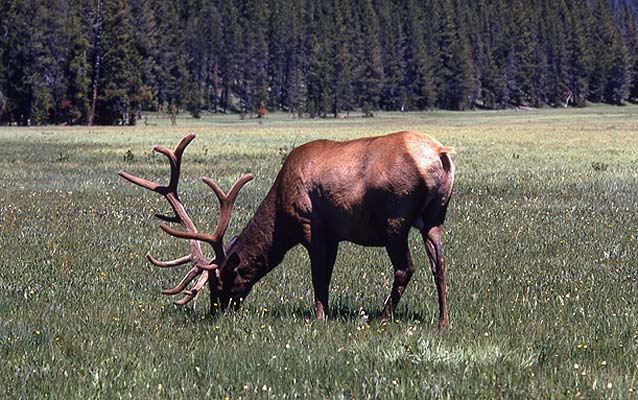Lesson Plan

Bull elk
- Grade Level:
- Third Grade-Eighth Grade
- Subject:
- Biology: Animals, Biology: Plants, Ecology, Wildlife Biology
- Group Size:
- Up to 36
- Setting:
- outdoors
- National/State Standards:
- WY Grade 4 Science: 1.5, 2.1, 2.2
WY Grade 8 Science: 1.4, 2.2
Next Generation Science Standards: K-LS1-1., K-ESS3-1.
Overview
In “To Eat or Be Eaten,” students demonstrate energy transfer and connections between plants and animals.Objective(s)
- Show the relationship between animals and plants in the food chain
- Explain the importance of a healthy food chain/web/cycle
- State the connections between predators, prey, and plants
Background
All living things, plants and animals, are connected as parts of a food chain. Some members of the food chain are producers, providing food for other organisms. Other members are consumers of those producers. Knowledge of the interrelationships and interdependencies of living things is important.Procedure
- Select which animals, plants, and energy sources to include in a web of life activity. Use the Eat or Be Eaten supplement (63 KB pdf) as your guide. Write the name and draw a picture of the animal/plant/energy source on the front side of the card. On the back of the card write what it eats and is eaten by. Loop a string through each card so students can wear the card like a necklace.
- Offer examples to explain the terms consumer, producer, herbivore, carnivore, omnivore, predator, and prey.
- Go outdoors to a large open space and provide instructions for a web of life activity without giving it a title.″
Have students form a circle.
Give students new names—Mr. Grizzly Bear, Ms. Mountain Lion, etc.
Pass out Life Cards for students to hang around their necks, picture side out. Attempt to position an animal across the circle from the food it might eat. (If it is a small group, go through the cards to select the most appropriate animals/plants and be sure to include the Sun card.)
Have students lose their voice, except when they have energy (the string).
Explain that only one card may start the game. Elicit finger pointing for who it might be. When they have determined that the Sun is the beginner of the game, have the Sun go to the center of the circle.
Give the end of the string to the Sun.
Have the Sun state whom he/she will give energy to. It must be one of the green plants. If necessary, review photosynthesis.″ Keep the string from sagging or becoming a tug-of-war object.
Have the Sun stay in the center while you walk the string to the plant. Continue to walk the string to each player as they are chosen. You will be in the web and may have to go through contortions to take the string to the next person.
Send the energy (string) back to someone who is already in the web if necessary to include all students. - Open a discussion by asking questions. What does this look like? What have you created? If we had time and string and many more hands, could we go around more times? What are some other possible relationships that you see in the circle? Where do humans fit into this web of life?
- Discuss the importance of a healthy ecosystem to enable everything to survive.Allow two or three students to jiggle their string with a large up and down motion while everyone else sits very still. Have the others look at their own string. If their string has wiggled even a little, they are somehow connected to the others. Do this a few times, using different students each time. What would happen to them if the ecosystem became unhealthy for the other inhabitants?
- Talk about each animal and plant as you wind the string. If there were a problem with the fish, the otter would be affected, etc. You could make scenarios up as you go, but this part needs to move right along.
- Have students take off their name tags and collect them.
NOTE: You also might include soil, shelter, or water in the circle, especially if you have more than 31 participants or want to include the adults. There are no cards for them (unless you/they make them), but they could remember their role and state it to the others. This would open discussion beyond just food/energy needs. The string would become more than just food energy.
Park Connections
Though visitors to Yellowstone often have a favorite animal or location in the park, it is important to realize that all living things are connected in their environment and that a healthy ecosystem includes ALL of its native components. The interdependence and connectedness of all things means that when one species is threatened, often many others will be as well.This “web of life” activity demonstrates the cascade of issues surrounding the population decline of native Yellowstone cutthroat trout due to the introduction of non-native lake trout in Yellowstone Lake. Many other species can be affected by the decline in cutthroat trout since they spawn in streams and swim closer to the surface than lake trout. Many wildlife species prey on cutthroat but may not be able to switch to catching lake trout because lake trout swim in deeper waters.
Extensions
Lead a group discussion or ask students to state why they think park managers reintroduced the grey wolf to the park after they had been intentionally exterminated decades earlier. What other animal and plant species may have been affected when wolves were absent from the park ecosystem for 60 years? What species may be affected by the return of a predator such as the wolf?What might happen if grizzly bears became extinct?
What might happen if the climate becomes markedly warmer and drier or weather patterns change drastically enough to alter plant communities and fire seasons?
Vocabulary
producer, consumer, herbivore, carnivore, omnivoreLast updated: February 24, 2015
